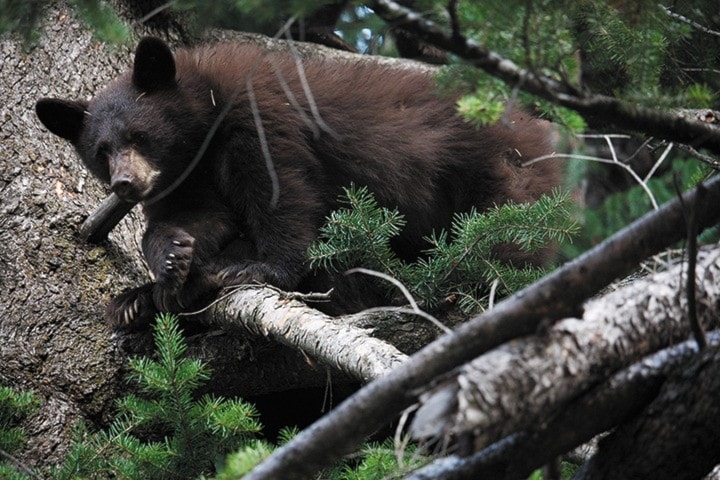Submitted by CrowsnestConservation BearSmart
Bears convey information to each other through body language, vocalizations and odour signals. During encounters with people, bears will respond and signal their intentions just as they would to any other bear.
A better understanding of how bears communicate will decrease the likelihood of a negative encounter or a misinterpreted interaction.
Even among grizzly bears, who are typically more assertive in their responses to threats, bears have evolved a language of dominance and submission to “work things out” with little physical contact.
Submissive behaviour occurs when a bear walks away from an encounter, sits or lies down or, in the case of black bears, climbs a tree. This behaviour says the bear does not want to challenge for the carcass, the female, etc. Similarly, a bear who yawns, looks away, and remains motionless is indicating that he wants to be left alone.
Dominance can be indicated by continued approach at a walk or run. A bear encountering a new or unknown situation may stand up on its hind legs to better assess its surroundings; this is normal, information gathering behaviour and not a sign of aggression.
A nervous or fearful bear will often indicate so by lunging forward, slapping the ground or a nearby object, and blowing loudly or snapping its teeth. Sometimes the blowing takes on a guttural quality that sounds almost like a growl but the behaviour should instead be interpreted as a warning from the uneasy bear to move away. Less commonly, the bear will bluff charge by running full-tilt at the threat but stopping just short of contact. Such bears are feeling very agitated and this can escalate to a potentially dangerous situation (especially with grizzly bears) if the threat is not removed (i.e., back away quickly but do not run).
Bears typically do not vocalize often, though vocal communications are more frequent between mothers and cubs and are more common from black bears than from grizzly bears.
Grunts and tongue clicks are used in friendly interactions between bears like mom/cubs, mates, and playmates. Cubs also produce a pulsing motor-like hum when nursing.
Woofing (loud blowing of air through nose or mouth), huffing, and jaw popping or chomping generally indicate fear, nervousness or apprehension on the part of the bear rather than an effort to threaten or a precursor to an attack. While the explosive sounds and associated behaviour, such as swatting the ground, may look threatening,
the bear is telling you it feels uncomfortable, thereby giving you the opportunity to diffuse the situation by retreating.
Threatened bears do not roar like in the movies.
The highest intensity vocalizations are expressed with an almost human-like voice and are used when in pain (bawling), in fear (moaning, cub distress squeal), in combat (bellowing), or when seriously threatened (deep-throated pulsing sound). A bear that is preying and stalking does not make a sound, but rather focuses intently in silence.
Scent-marking often occurs on trees when bears stand on their hind legs and rub their backs and shoulders to leave scent and hair. The behaviour broadcasts information on the identity, age and sex of individual bears in the vicinity and the breeding condition of females. Male bears may also bite or claw at trees to communicate dominance during the breeding season. The same trees are used repeatedly over many years. So while the human nose can’t glean the same information as a local bear, the presence of such bear rub trees can tell us that we are travelling along a well-used bear travel path and thus must remain alert.
So can bears speak? Perhaps they don’t use a full language like we do, but they certainly do use body position, vocalizations, and scent to send messages.
Next time you come across a bear, think about what message the bear is conveying, and respond accordingly in bear-ese (e.g., backing away means you don’t want confrontation, yelling loudly could be perceived as a threat if it frightens cubs).
Bear sightings should be reported to Fish and Wildlife during office hours at (403) 562-3289 and after hours to the Report-a-Poacher hotline at (800) 642-3800. For more information contact (403) 563-0058.
